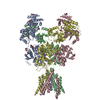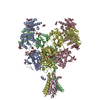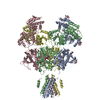[English] 日本語
 Yorodumi
Yorodumi- PDB-7yfm: Structure of GluN1b-GluN2D NMDA receptor in complex with agonists... -
+ Open data
Open data
- Basic information
Basic information
| Entry | Database: PDB / ID: 7yfm | ||||||||||||||||||
|---|---|---|---|---|---|---|---|---|---|---|---|---|---|---|---|---|---|---|---|
| Title | Structure of GluN1b-GluN2D NMDA receptor in complex with agonists glycine and glutamate. | ||||||||||||||||||
 Components Components |
| ||||||||||||||||||
 Keywords Keywords |  ELECTRON TRANSPORT / ELECTRON TRANSPORT /  ion channel / cryo-EM structure / ion channel / cryo-EM structure /  glutamate receptor / synaptic protein glutamate receptor / synaptic protein | ||||||||||||||||||
| Function / homology |  Function and homology information Function and homology informationexcitatory chemical synaptic transmission / regulation of sensory perception of pain / Synaptic adhesion-like molecules / cellular response to L-glutamate / propylene metabolic process / response to glycine / voltage-gated monoatomic cation channel activity / glutamate-gated calcium ion channel activity / regulation of monoatomic cation transmembrane transport / Assembly and cell surface presentation of NMDA receptors ...excitatory chemical synaptic transmission / regulation of sensory perception of pain / Synaptic adhesion-like molecules / cellular response to L-glutamate / propylene metabolic process / response to glycine / voltage-gated monoatomic cation channel activity / glutamate-gated calcium ion channel activity / regulation of monoatomic cation transmembrane transport / Assembly and cell surface presentation of NMDA receptors / Neurexins and neuroligins /  NMDA glutamate receptor activity / NMDA selective glutamate receptor complex / calcium ion transmembrane import into cytosol / protein heterotetramerization / NMDA glutamate receptor activity / NMDA selective glutamate receptor complex / calcium ion transmembrane import into cytosol / protein heterotetramerization /  glutamate binding / positive regulation of reactive oxygen species biosynthetic process / glutamate binding / positive regulation of reactive oxygen species biosynthetic process /  glycine binding / positive regulation of calcium ion transport into cytosol / Negative regulation of NMDA receptor-mediated neuronal transmission / glycine binding / positive regulation of calcium ion transport into cytosol / Negative regulation of NMDA receptor-mediated neuronal transmission /  startle response / Unblocking of NMDA receptors, glutamate binding and activation / regulation of neuronal synaptic plasticity / monoatomic cation transmembrane transport / positive regulation of excitatory postsynaptic potential / startle response / Unblocking of NMDA receptors, glutamate binding and activation / regulation of neuronal synaptic plasticity / monoatomic cation transmembrane transport / positive regulation of excitatory postsynaptic potential /  Long-term potentiation / monoatomic cation transport / ligand-gated monoatomic ion channel activity / Long-term potentiation / monoatomic cation transport / ligand-gated monoatomic ion channel activity /  excitatory synapse / calcium ion homeostasis / excitatory synapse / calcium ion homeostasis /  synaptic cleft / presynaptic active zone membrane / glutamate-gated receptor activity / ligand-gated monoatomic ion channel activity involved in regulation of presynaptic membrane potential / EPHB-mediated forward signaling / synaptic cleft / presynaptic active zone membrane / glutamate-gated receptor activity / ligand-gated monoatomic ion channel activity involved in regulation of presynaptic membrane potential / EPHB-mediated forward signaling /  excitatory postsynaptic potential / hippocampal mossy fiber to CA3 synapse / ionotropic glutamate receptor signaling pathway / Ras activation upon Ca2+ influx through NMDA receptor / excitatory postsynaptic potential / hippocampal mossy fiber to CA3 synapse / ionotropic glutamate receptor signaling pathway / Ras activation upon Ca2+ influx through NMDA receptor /  regulation of membrane potential / positive regulation of synaptic transmission, glutamatergic / adult locomotory behavior / transmitter-gated monoatomic ion channel activity involved in regulation of postsynaptic membrane potential / regulation of membrane potential / positive regulation of synaptic transmission, glutamatergic / adult locomotory behavior / transmitter-gated monoatomic ion channel activity involved in regulation of postsynaptic membrane potential /  synaptic membrane / synaptic membrane /  synaptic transmission, glutamatergic / long-term synaptic potentiation / postsynaptic density membrane / synaptic transmission, glutamatergic / long-term synaptic potentiation / postsynaptic density membrane /  brain development / brain development /  regulation of synaptic plasticity / regulation of synaptic plasticity /  visual learning / visual learning /  terminal bouton / terminal bouton /  synaptic vesicle / synaptic vesicle /  signaling receptor activity / signaling receptor activity /  amyloid-beta binding / RAF/MAP kinase cascade / chemical synaptic transmission / amyloid-beta binding / RAF/MAP kinase cascade / chemical synaptic transmission /  postsynaptic membrane / response to ethanol / postsynaptic membrane / response to ethanol /  dendritic spine / dendritic spine /  postsynaptic density / postsynaptic density /  calmodulin binding / neuron projection / calmodulin binding / neuron projection /  synapse / glutamatergic synapse / synapse / glutamatergic synapse /  dendrite / dendrite /  calcium ion binding / protein-containing complex binding / endoplasmic reticulum membrane / calcium ion binding / protein-containing complex binding / endoplasmic reticulum membrane /  cell surface / positive regulation of transcription by RNA polymerase II / cell surface / positive regulation of transcription by RNA polymerase II /  plasma membrane / plasma membrane /  cytoplasm cytoplasmSimilarity search - Function | ||||||||||||||||||
| Biological species |   Homo sapiens (human) Homo sapiens (human) | ||||||||||||||||||
| Method |  ELECTRON MICROSCOPY / ELECTRON MICROSCOPY /  single particle reconstruction / single particle reconstruction /  cryo EM / Resolution: 5.1 Å cryo EM / Resolution: 5.1 Å | ||||||||||||||||||
 Authors Authors | Zhang, J.L. / Zhu, S.J. / Zhang, M. | ||||||||||||||||||
| Funding support |  China, 5items China, 5items
| ||||||||||||||||||
 Citation Citation |  Journal: Nat Struct Mol Biol / Year: 2023 Journal: Nat Struct Mol Biol / Year: 2023Title: Distinct structure and gating mechanism in diverse NMDA receptors with GluN2C and GluN2D subunits. Authors: Jilin Zhang / Ming Zhang / Qinrui Wang / Han Wen / Zheyi Liu / Fangjun Wang / Yuhang Wang / Fenyong Yao / Nan Song / Zengwei Kou / Yang Li / Fei Guo / Shujia Zhu /  Abstract: N-methyl-D-aspartate (NMDA) receptors are heterotetramers comprising two GluN1 and two alternate GluN2 (N2A-N2D) subunits. Here we report full-length cryo-EM structures of the human N1-N2D di- ...N-methyl-D-aspartate (NMDA) receptors are heterotetramers comprising two GluN1 and two alternate GluN2 (N2A-N2D) subunits. Here we report full-length cryo-EM structures of the human N1-N2D di-heterotetramer (di-receptor), rat N1-N2C di-receptor and N1-N2A-N2C tri-heterotetramer (tri-receptor) at a best resolution of 3.0 Å. The bilobate N-terminal domain (NTD) in N2D intrinsically adopts a closed conformation, leading to a compact NTD tetramer in the N1-N2D receptor. Additionally, crosslinking the ligand-binding domain (LBD) of two N1 protomers significantly elevated the channel open probability (Po) in N1-N2D di-receptors. Surprisingly, the N1-N2C di-receptor adopted both symmetric (minor) and asymmetric (major) conformations, the latter further locked by an allosteric potentiator, PYD-106, binding to a pocket between the NTD and LBD in only one N2C protomer. Finally, the N2A and N2C subunits in the N1-N2A-N2C tri-receptor display a conformation close to one protomer in the N1-N2A and N1-N2C di-receptors, respectively. These findings provide a comprehensive structural understanding of diverse function in major NMDA receptor subtypes. | ||||||||||||||||||
| History |
|
- Structure visualization
Structure visualization
| Structure viewer | Molecule:  Molmil Molmil Jmol/JSmol Jmol/JSmol |
|---|
- Downloads & links
Downloads & links
- Download
Download
| PDBx/mmCIF format |  7yfm.cif.gz 7yfm.cif.gz | 430.3 KB | Display |  PDBx/mmCIF format PDBx/mmCIF format |
|---|---|---|---|---|
| PDB format |  pdb7yfm.ent.gz pdb7yfm.ent.gz | 327.1 KB | Display |  PDB format PDB format |
| PDBx/mmJSON format |  7yfm.json.gz 7yfm.json.gz | Tree view |  PDBx/mmJSON format PDBx/mmJSON format | |
| Others |  Other downloads Other downloads |
-Validation report
| Arichive directory |  https://data.pdbj.org/pub/pdb/validation_reports/yf/7yfm https://data.pdbj.org/pub/pdb/validation_reports/yf/7yfm ftp://data.pdbj.org/pub/pdb/validation_reports/yf/7yfm ftp://data.pdbj.org/pub/pdb/validation_reports/yf/7yfm | HTTPS FTP |
|---|
-Related structure data
| Related structure data |  33793MC  7yffC  7yfgC  7yfhC  7yfiC  7yflC  7yfoC  7yfrC  8hdkC C: citing same article ( M: map data used to model this data |
|---|---|
| Similar structure data | Similarity search - Function & homology  F&H Search F&H Search |
- Links
Links
- Assembly
Assembly
| Deposited unit | 
|
|---|---|
| 1 |
|
- Components
Components
| #1: Protein | Mass: 97777.914 Da / Num. of mol.: 2 Source method: isolated from a genetically manipulated source Source: (gene. exp.)   Homo sapiens (human) / Gene: GRIN1, NMDAR1 / Plasmid: pEG-BacMam / Cell (production host): Kidney embryonic cells / Cell line (production host): HEK293S GnTI- / Production host: Homo sapiens (human) / Gene: GRIN1, NMDAR1 / Plasmid: pEG-BacMam / Cell (production host): Kidney embryonic cells / Cell line (production host): HEK293S GnTI- / Production host:   Homo sapiens (human) / References: UniProt: Q05586 Homo sapiens (human) / References: UniProt: Q05586#2: Protein | Mass: 97226.414 Da / Num. of mol.: 2 Source method: isolated from a genetically manipulated source Source: (gene. exp.)   Homo sapiens (human) / Gene: GRIN2D, GluN2D, NMDAR2D / Plasmid: pEG-BacMam / Cell line (production host): HEK293S GnTI- / Production host: Homo sapiens (human) / Gene: GRIN2D, GluN2D, NMDAR2D / Plasmid: pEG-BacMam / Cell line (production host): HEK293S GnTI- / Production host:   Homo sapiens (human) / References: UniProt: O15399 Homo sapiens (human) / References: UniProt: O15399 |
|---|
-Experimental details
-Experiment
| Experiment | Method:  ELECTRON MICROSCOPY ELECTRON MICROSCOPY |
|---|---|
| EM experiment | Aggregation state: PARTICLE / 3D reconstruction method:  single particle reconstruction single particle reconstruction |
- Sample preparation
Sample preparation
| Component | Name: NMDA receptor with NMDA 1 incorperated with NMDA 2D / Type: COMPLEX / Entity ID: all / Source: RECOMBINANT | |||||||||||||||
|---|---|---|---|---|---|---|---|---|---|---|---|---|---|---|---|---|
| Molecular weight | Value: 384.54 kDa/nm / Experimental value: NO | |||||||||||||||
| Source (natural) | Organism:   Homo sapiens (human) / Strain: Homo sapiens / Cellular location: plasma membrane / Organ: brain / Organelle Homo sapiens (human) / Strain: Homo sapiens / Cellular location: plasma membrane / Organ: brain / Organelle : synapse / Tissue: brain : synapse / Tissue: brain | |||||||||||||||
| Source (recombinant) | Organism:   Homo sapiens (human) / Strain: Homo sapiens / Cell: Kidney embryonic cells / Plasmid Homo sapiens (human) / Strain: Homo sapiens / Cell: Kidney embryonic cells / Plasmid : pEG-BacMam : pEG-BacMam | |||||||||||||||
| Buffer solution | pH: 8 | |||||||||||||||
| Buffer component |
| |||||||||||||||
| Specimen | Conc.: 4 mg/ml / Embedding applied: NO / Shadowing applied: NO / Staining applied : NO / Vitrification applied : NO / Vitrification applied : YES / Details: This sample was monodisperse. : YES / Details: This sample was monodisperse. | |||||||||||||||
| Specimen support | Grid material: GOLD / Grid mesh size: 300 divisions/in. / Grid type: Quantifoil R1.2/1.3 | |||||||||||||||
Vitrification | Instrument: FEI VITROBOT MARK IV / Cryogen name: ETHANE / Humidity: 100 % / Chamber temperature: 281 K / Details: Blot for 3 seconds before plunging |
- Electron microscopy imaging
Electron microscopy imaging
| Experimental equipment |  Model: Titan Krios / Image courtesy: FEI Company |
|---|---|
| Microscopy | Model: FEI TITAN KRIOS |
| Electron gun | Electron source : :  FIELD EMISSION GUN / Accelerating voltage: 300 kV / Illumination mode: FLOOD BEAM FIELD EMISSION GUN / Accelerating voltage: 300 kV / Illumination mode: FLOOD BEAM |
| Electron lens | Mode: BRIGHT FIELD Bright-field microscopy / Nominal defocus max: 2500 nm / Nominal defocus min: 1500 nm Bright-field microscopy / Nominal defocus max: 2500 nm / Nominal defocus min: 1500 nm |
| Image recording | Electron dose: 60 e/Å2 / Detector mode: SUPER-RESOLUTION / Film or detector model: DIRECT ELECTRON DE-10 (5k x 4k) / Num. of grids imaged: 1 / Num. of real images: 8700 |
| Image scans | Movie frames/image: 40 / Used frames/image: 1-40 |
- Processing
Processing
| Software | Name: PHENIX / Version: 1.20.1_4487: / Classification: refinement | ||||||||||||||||||||||||||||||||||||||||
|---|---|---|---|---|---|---|---|---|---|---|---|---|---|---|---|---|---|---|---|---|---|---|---|---|---|---|---|---|---|---|---|---|---|---|---|---|---|---|---|---|---|
| EM software |
| ||||||||||||||||||||||||||||||||||||||||
CTF correction | Type: NONE | ||||||||||||||||||||||||||||||||||||||||
| Particle selection | Num. of particles selected: 678197 | ||||||||||||||||||||||||||||||||||||||||
| Symmetry | Point symmetry : C2 (2 fold cyclic : C2 (2 fold cyclic ) ) | ||||||||||||||||||||||||||||||||||||||||
3D reconstruction | Resolution: 5.1 Å / Resolution method: FSC 0.143 CUT-OFF / Num. of particles: 98449 / Num. of class averages: 2 / Symmetry type: POINT | ||||||||||||||||||||||||||||||||||||||||
| Atomic model building | B value: 230 / Protocol: FLEXIBLE FIT / Space: REAL / Target criteria: Correlation coefficient | ||||||||||||||||||||||||||||||||||||||||
| Atomic model building | PDB-ID: 6WI1 | ||||||||||||||||||||||||||||||||||||||||
| Refine LS restraints |
|
 Movie
Movie Controller
Controller










 PDBj
PDBj










